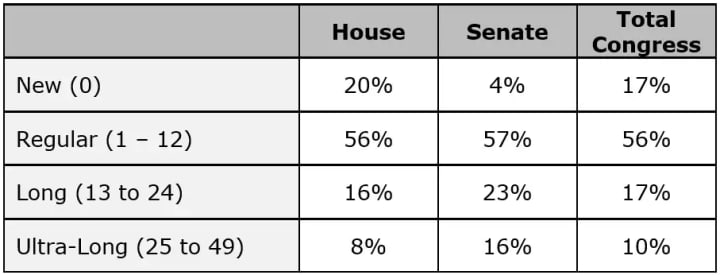» KEY POINTS
- Being a Congressperson was never meant to be a full-time job, nonetheless one that people make a career out of.
- No person should be able to serve in the House of Representatives or Senate for more than two terms.
- Term limits should extend to the entirety of all governments where no person should be able to spend more than 25 years at any level of government at any elected, appointed, or confirmed position.

Among all that staff that works for Congress, there are about 600 who are in the employ of the Congressional Research Service (CRS). In late 2018, the CRS finally started making its non-confidential publications available to the public (and not only to be seen by members of Congress). One of the first publications on January 3, 2019 was an analysis of the tenures of members of Congress over time. According to this agency, in the 116th Congress the average years for members of the House of Representatives was 8.6 years while the Senate was 10.1 years. Average is an interesting statistic, but distribution gives a clearer picture:

To arrive at these numbers, we must include all time served in the House and the Senate. Within the Senate, 40% of the members have prior experience serving in the House at an average of almost nine years. Even ten members of the House have prior experience in the same chamber with an average additional nearly six years of time. But that is hardly the end of this! Many members of both chambers have large amounts of prior experience in government as legislators at the State level, Governors, appointed positions, and more. In other words, the vast majority of the Legislative Branch is filled with long-time employees of one government or another.
Even the year this report was originally commissioned is a bit of an anomaly. If you recall, re-election rates are incredibly high among all members of Congress. The key factor that truly impacts tenure right now is the decision of the Congresspeople whether to run again or not. Just comparing the average tenures of that Congress to the one before it would make you think it was dropping, but two years are not a trend. The CRS shows a chart that makes it clear: since the beginning of the first Congress the tenure time in the Legislative Branch has been on a straight upward trajectory. Sure, there are dips and bumps as you go, but tenure has been roiling upwards, most especially post the Civil War.
Are you starting to see the connection in timelines? Starting in the 1850’s is when Congress gave itself full-time salaries, and that is when the shift began to happen. Before the 1870’s the average tenure for Senators hovered around 4 years and the House around 2 years. Yet, as a full-time salary was created and further grown, the tenures started going up and up. Mind you, those earlier years were impacted by the large number of new States joining the union, so the average is depressed. But in general, we have incentivized the idea of making working in the legislature and government in general a career (a lucrative career at that) instead of a service.
To further demonstrate this point, the CRS looked at the rates by which Congresspeople sought re-election. From the first Congress through the 1850’s, the rate by which people attempted another term was on a downward trajectory and had reached below 50%. Then, with the advent of a full-time salary there was a sharp turn that brought the rate we see today in the in the 80% to 90% range. Therefore, 80% to 90% choose to run for re-election, and get re-elected 80% to 95% of the time. As such, very few people are being removed by election and most are just by natural attrition. Some may not run because they believe they will lose and instead choose to retire, but that does not prove that they would have lost their positions in a full election.
Returning to time in office, we should pay particular attention to those who have served in Congress in the Long and Ultra-Long categories. Within all of Congress, 27% have spent more than 13 years (and by 2019 maxing out at 46 years, though that has and will continue to go up every year after this is written) in Congress — again not including time spent in other government positions. That is more than 2 full Senate terms and 6 full House terms. The CRS comes to many of the same analysis points and more; yet does not come to any conclusions.
Here is the conclusion that they refused to write: too much time in office is the antithesis of a representative democracy. Recall earlier when we looked at the average age of Congresspeople and how it does not come close to the alignment of the American people. That is because people join Congress and for the most part never leave. Being in Congress creates an inherent bubble around legislators that disconnects them from the actual concerns and opinions of their constituents. There needs to be turnover in order to get current perspectives and knowledge into the government.
This is even more important in the system we have laid out throughout this entire legislative-focused section, particularly with the House. If the Political Parties are responsible for creating Lists of who is going to sit in the House, they would just put their longest tenured and most powerful Party members in those roles and leave them there forever. No, we need one final Amendment to Article 1 to add term limits to serving in Congress.
By Amendment to the Constitution of the United States, Article 1, Section 6, Clause 5 shall be added.
No person shall be elected to the House of Representatives more than twice nor to the Senate more than twice, and not more than four times for all of Congress. And no person who has held a position in Congress for more than two years of a term to which some other person was elected shall be elected to the House of Representatives or the Senate more than once. But this clause shall not apply to any person holding a position in Congress at the time of ratification until the end of his current term.
Does that read familiar? It is practically an exact crib (some would say plagiarism) of the 22nd Amendment that limited the President to two terms. Prior to Franklin Delano Roosevelt, no President had ever served more than two terms as they saw it a service point to leave. After FDR, it was clear that a rule was needed to force the issue and make sure that no one person could amass that much power and control of American policy and future. The progression to ultra-long serving members of Congress has been a much more gradual slide, so it has not hit as many people in the face like FDR did. Besides, Congress was on board with limiting the power of the President; they are not so with limiting their own power and earning potential.

This Amendment would limit employment to two terms in each chamber of Congress, but does allow a person to serve in both for up to two terms each. If we accept the prior Amendments to make the House and the Senate four-year terms that happen at the same time, it means a person could serve up to 8 years in the House and then potentially immediately after that another 8 years in the Senate for a total of 16 years (or vice versa). There is a sub-clause in there to make sure current members of Congress are not kicked out in the middle of their terms just because they have previously timed out but that they are allowed to serve their term out until its natural conclusion.
Sixteen years may seem long, but it only the potential and requires moving between two different chambers and winning in two different systems. Based on Lists for the House, people may lose their seat and have to come back in later or not at all, so overall it should still end up with a good amount of new blood while allowing a fair amount of long-term people to stay involved. After all, it is reasonable to have both brand-new people and those with experience on a regular basis, but at the same time make sure no one is serving for an entire generation.
However, as discussed, that has not limited how much time these people could spend in any level of government. With former State-level legislators, Governors, Presidents, Judges, appointed positions — there are just too many other nooks and crannies that a person looking to make a career out of politics could sneak in to and have the government cover the bill. If a Party wants to pay its members for its services, that is the Party’s business. That does not mean that the government should be paying for the Party to retain and use its power and influence. Because of that, we need one last Amendment to make sure all of government is safe from the careerists:
By Amendment to the Constitution of the United States, Article 8, Section 1, Clause 1 shall be added.
No person shall serve more than a combined twenty-five years in total in any elected or appointed position or combination thereof within any part of government, with no differentiation between local, State or Territory, Federal, or Foreign government. But this clause shall not apply to any person holding an elected or appointed position at the time of ratification until the end of his current term. Additionally, this Clause does not apply to staff and civil servants that support the functions of Government, nor those serving in the military or militia.
It is worth noting that the Constitution only has 7 Articles (less the Amendments), so Article 8 would be a net new one. We are going to call this Article “Limitations of Government”. This should not be a surprise at this point, but later in this document we will be adding several more Clauses to this section to further limit the Government and grant rights to the people directly through another Article.
For now, this first Clause for Article 8 is about limiting the total amount of time that someone can spend working in Government; not just the Federal Government, but all of Government in any role that is not a support staff or public servant position or involved with the military. Those people are employees, but when it comes to elected and appointed positions, they are supposed to be in service. As such, they need to time out so that we do not create despots. Despots need not be the dictator of an entire nation, but they can be someone who controls which legislation is available for debate, which organizations get money, or who can participate in the PTA bake sale. We need a function to clear away people who have served for too long not because they necessarily are bad people or have done anything wrong, but simply because service is supposed to be temporary and we need new and different ideas on a regular basis.
At 25 years, a person could spend 8 years serving in the House, 8 years serving in the Senate, and 8 years serving as President with one year left over. Or a person could spend 12 years as their Town Selectman, 10 years as Mayor, and 3 years as Governor. Or another person could spend all 25 years being a Judge. The possibilities and paths will be up to the individual if and how they want to serve. Do you want to spend your limited years as a Secretary for the President? Do you want to be a Judge when you might want to be Governor? Will you spend 20 years on the PTO even if your children are grown and moved on? It forces a changeover in every single organization within every level of government. There is some math that must be done and people will need to make decisions. What is most important to your service? Is it a local issue or a national one? When do you start? When do you finish? Do you take a break?
Most importantly, it limits (though does not eliminate, other laws would need to do that) a bit of cronyism. For instance, the President could not just appoint someone to a plush government position that has no turnover. That would not be a support or civil servant position, so that person would have to realize that if they wanted to do something else (like be a Senator), they could not stay in that position forever. These rewards would be fewer and further between.
When you lay it out, 25 years is roughly a generation. Someone could be in the eye of the public and in service to it for all that time, but then another generation can come in. It will not work out perfectly like that because everyone will be on different schedules and experiences, but there would be a constant sweep of new people ready to be in service to our country with fresh ideas and hopeful desires.

The above piece is a mildly modified excerpt from New & Improved: The United States of America by J.P. Prag, available at booksellers worldwide.

Learn more about author J.P. Prag at www.jpprag.com.

An earlier version of this article appeared on Medium.
About the Creator
J.P. Prag
J.P. Prag is the author of "Aestas ¤ The Yellow Balloon", "Compendium of Humanity's End", "254 Days to Impeachment", "Always Divided, Never United", "New & Improved: The United States of America", and more! Learn more at www.jpprag.com.







Comments (1)
Excellent article, and I am behind you 100%.